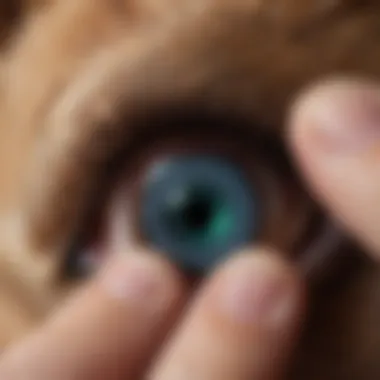Microchipping Your Dog: A Complete Guide


Intro
Microchipping pets has gained increasing attention among dog owners. This technology serves as a vital asset in enhancing the safety and well-being of our dogs. Understanding the microchipping process can help pet owners make informed decisions. It involves several aspects, which include the technology behind microchips, benefits, implantation procedures, aftercare, and more. Gaining knowledge about this process is essential, especially if you want to take proactive measures in ensuring your dog’s return in case it gets lost.
Pet Care Essentials
Microchipping is just one facet of comprehensive pet care. A responsible dog owner considers various elements that contribute to the health and happiness of their pet.
Daily Nutrition Requirements
A proper diet is crucial for your dog's health. Owners should focus on balanced nutrition tailored to their dog's breed, age, and health condition. Ingredients should prioritize proteins, fats, carbohydrates, vitamins, and minerals. Consult your veterinarian for personalized feeding recommendations.
Exercise and Playtime
Maintaining an active lifestyle is important for dogs. Regular exercise is necessary for physical health and mental stimulation. Daily walks, playtime at the park, and interactive toys contribute to a well-rounded exercise routine.
Grooming Tips
Regular grooming is essential for comfort and hygiene. Brush your dog's coat according to its type and breed. Bathing should be done as needed, using pet-friendly products. Nail trimming and dental care also play significant roles in a dog's overall well-being.
Health and Wellness Check-ins
Frequent veterinary check-ups ensure your dog is in good health. Preventative care, vaccinations, and parasite control are vital. Discuss any behavioral changes or health concerns with your veterinarian to address potential issues early.
Behavior & Training
Understanding dog behavior is critical for building strong connections with them.
Understanding Your Pet's Body Language
Recognizing signs of stress, happiness, and fear through body language is essential for pet owners. Dogs communicate non-verbally, so understanding these cues can lead to better training and a healthier relationship.
Basic Training Techniques
Training should begin from a young age. Basic commands such as sit, stay, or come are fundamental for safety and obedience. Positive reinforcement methods prove effective to encourage desired behavior.
Behavioral Concerns & Solutions
Common behavioral issues include barking, chewing, and aggression. Identifying the root cause can assist in finding effective solutions. Professional training services might be necessary in some cases.
Socialization Tips
Socializing your dog is critical for its emotional health. Expose your dog to various environments, individuals, and other animals to build confidence and reduce anxiety.
Pet Home Environment
Creating an optimal living space is necessary for your dog's comfort and safety.
Creating a Pet-friendly Space
Clear spaces of harmful items that dogs might ingest. Designate an area for eating, playing, and resting. This creates a restorative environment catering to your pet's needs.
Safety Measures and Hazards to Avoid
Be vigilant about common household hazards. Ensure cleaning supplies, human foods, and small objects are out of reach. Gate off stairs and secure trash cans to prevent access.
Choosing the Right Toys and Accessories
Selecting toys suitable for your dog's size and chewing habits is important. Interactive toys stimulate engagement while comfort toys can help ease anxiety.
Setting Up a Comfortable Resting Area
A designated sleeping space promotes relaxation and security. Choose a comfortable bed, and place it in a quiet area of the home.
Pet Health Issues
Addressing health concerns is a crucial aspect of dog ownership.
Recognizing Signs of Illness
Being aware of signs indicating an underlying health issue helps catch problems early. Watch for changes in behavior, appetite, and energy levels.
Preventative Care Measures


Regular vaccinations, flea, and tick prevention contribute to a dog's health. Discuss appropriate medications and treatments with your veterinarian.
Common Ailments and Treatments
Ailments such as allergies, ear infections, and dental issues are common. Knowing the signs can lead to timely veterinary intervention. Treat minor issues at home with vet-recommend solutions.
Emergency Preparedness
Prepare for emergencies by keeping a first-aid kit and knowing your vet's contact details. Cock in a plan for reacting in case of loss, injury, or sickness to ensure your pet’s safety.
Investing time and effort into understanding your dog's needs enhances their quality of life and fosters a strong bond.
Intro to Microchipping
Microchipping is an essential procedure for dog owners. It provides a permanent way to identify pets, enhancing their safety and increasing the chances of reunion if they get lost. With a simple, small device implanted under the skin, a microchip can offer peace of mind to concerned pet owners. As stray or lost pets can often be mistaken for local ones, microchipping plays a vital role in distinguishing your dog in case of any mishap.
Understanding microchipping involves several components. Pet owners must learn not only about the technology and its workings but also the benefits and responsibilities that come with it.
What is a Microchip?
A microchip is a small electronic device about the size of a grain of rice. It is typically encased in a biocompatible glass to ensure that it is safe for implantation in the animal's body. Each microchip has a unique identification number. This number is linked to the owner's information stored in a database, allowing for easy identification.
The implantation of a microchip is a quick and generally painless procedure. It involves the use of a syringe to insert the microchip just under the skin, usually between the shoulder blades. Once implanted, the chip can last a lifetime without needing any maintenance.
Why Microchip Your Dog?
The benefits of microchipping are numerous. First and foremost, it acts as a safeguard against loss. According to a study by the ASPCA, microchipped dogs are significantly more likely to be returned to their owners compared to those without a chip. Here are some key reasons:
- Permanent Identification: Unlike collars or tags that can be lost or removed, microchips remain with the dog throughout its life.
- Easy Recovery: Shelters and veterinary clinics are equipped with scanners that can easily read the microchip, making it easier to find lost pets.
- Peace of Mind: Knowing that there is a reliable way to identify your pet can reduce anxiety for pet owners.
In summary, microchipping is a crucial process that every responsible dog owner should consider. It connects owners to their pets and offers reassurance that, should the worst happen, there is a way to bring them home.
Understanding Microchip Technology
Understanding microchip technology is vital for pet owners who want to enhance the safety of their dogs. Microchips are small devices that provide permanent identification. They work wirelessly, allowing shelters and vets to locate the owner when a lost dog is found. This technology is essential for preventing loss of pets, which can be distressing for pet owners.
Microchips function using radio frequency identification (RFID), a system that uses electromagnetic fields to transfer data. They have a unique identification number programmed into them. When scanned, the number connects to a database with information about the pet and owner. This ensures that even if your dog gets lost, they can be identified quickly and returned home.
Moreover, understanding the types of microchips available helps pet owners to make informed choices regarding their dog's identification. Different brands may offer varying features, such as microchip size, frequency, and compatibility with scanners at veterinary offices and animal shelters. Knowing these differences can help pet owners select the right microchip that fits their needs.
How Microchips Work
Microchips are small devices, roughly the size of a grain of rice. When implanted beneath the dog's skin, they remain there for life, requiring no power source. Each microchip emits a unique number when triggered by a scanner. This occurs through radio waves emitted from the scanner, which prompts the chip to send back its identification number.
Once this number is scanned, it connects to a database. Database records usually include the pet's name, owner's contact information, and sometimes medical history. This system functions without batteries or maintenance.
The microchipping procedure is simple and can be performed by veterinarians. It involves minimal discomfort to the pet, akin to a standard vaccination. After implantation, the chip integrates with the dog's body and functions effectively for years.
Types of Microchips Available
When choosing a microchip for your dog, you will find various options in the market. Here are some aspects to consider when selecting from the types available:
- Compatibility: Ensure the microchip is compatible with local shelters and veterinary services. Some scanners read only specific frequencies.
- Brand Reputation: Research the brands available. Companies such as HomeAgain, Avid, and Trovan have established credibility in the microchip industry.
- Personalization Options: Some brands may offer features like access to a lost pet network, which can increase the chances of reunification.
"A microchip is your pet’s best chance of returning home if they ever go missing."
Choosing a Veterinarian
Selecting a veterinarian for microchipping your dog is a critical decision. This choice impacts not just the microchipping procedure but also the ongoing health care of your pet. A qualified veterinarian will ensure that the microchip is safely and correctly implanted. Their experience plays a significant role in minimizing discomfort and complications.
When considering a veterinarian, look for one who demonstrates a strong understanding of microchipping technology. They should also have a vested interest in the welfare of animals. Ensure that the vet you choose is properly accredited and has experience in performing the microchipping procedure safely. A vet who is part of a reputable practice will likely adhere to high standards of care, benefiting both you and your dog.
Moreover, communication is key in this relationship. A good veterinarian will explain the procedure clearly and address any queries you might have. This can ease your anxiety and help you feel confident in your choice.
Factors to Consider
When choosing a veterinarian for microchipping, consider the following factors:
- Experience and Expertise: Look for a veterinarian who specializes in small animals. Experience with microchipping specifically is important.
- Reputation: Seek recommendations from friends, family, or online resources. A practice with positive reviews is often a good sign.
- Facility and Staff: Visit the clinic if possible. A clean, well-organized facility with friendly, knowledgeable staff is essential.
- Follow-Up Care: Ensure that your chosen veterinarian offers follow-up services to monitor the microchip site and address any issues.
- Cost Transparency: Ask about the costs associated with microchipping, including any additional fees for registration.
Questions to Ask the Veterinarian
During your consultation, it is wise to ask specific questions to gauge the vet's suitability:


- How many microchips have you implanted?
- What brand of microchips do you use, and why?
- Can you explain the implantation process?
- What are the common side effects or complications?
- Do you provide a registration service for the microchip?
- What is the protocol for retrieval if my pet goes missing?
Asking these questions helps you understand both the veterinarian's expertise and the quality of care your dog will receive.
Taking the time to choose the right veterinarian is an investment in your pet’s safety and overall health. The vet plays a pivotal role not only in the implantation procedure but also in ensuring long-term wellness through regular checkups and vaccinations.
The Microchipping Process
Microchipping your dog is a critical step in ensuring their safety and well-being. This process is designed to provide a permanent form of identification for pets. In the unfortunate event that your dog gets lost, a microchip can significantly increase the chances of a prompt reunion with you. Understanding what this process entails, including what happens during the procedure and how to manage any discomfort, is essential for every pet owner.
What to Expect During the Procedure
When you take your dog in for microchipping, you can expect a straightforward and quick procedure. The entire process usually takes no longer than a few minutes. Here’s a detailed look at the steps involved:
- Identification: The veterinarian will verify your dog’s identity and obtain any necessary medical history.
- Preparation: The veterinarian will prepare the microchip, which is about the size of a grain of rice, and sterilize the area on your dog's skin where the chip will be implanted.
- Implantation: The microchip will be inserted under the skin between the shoulder blades using a specialized needle. Most dogs do not require anesthesia for this, as it is a relatively quick procedure.
- Post-Procedure Care: The veterinarian will offer instructions on aftercare and what to watch for in the following days.
Understanding these steps will help alleviate any anxiety you may feel about the process. It is quick, carried out by a professional, and involves minimal discomfort for your pet.
Pain Management During Microchipping
The concern for many pet owners is the pain their dogs might experience during the microchipping procedure. Here are key points to consider on pain management:
- Minimal Discomfort: The microchipping itself is similar to getting a vaccination. Most dogs experience only a brief moment of discomfort when the chip is inserted. Some may feel a pinch, but the sensation usually passes quickly.
- Post-Procedure Care: After the procedure, it is important to monitor your dog for any unusual behavior. Though most dogs recover quickly, some may show temporary signs of sensitivity at the site.
- Veterinary Advice: Your veterinarian can provide recommendations for over-the-counter pain relief, such as medications suitable for dogs, if your pet shows signs of discomfort after microchipping.
It is crucial to address pain management during and after microchipping. Taking care of your dog ensures a better recovery and enhances their comfort.
In summary, the microchipping process is a vital aspect of responsible pet ownership. Understanding what to expect during the procedure and how to manage pain will contribute to a positive experience for both you and your dog. This knowledge empowers pet owners to make informed decisions that protect their furry friends.
Post-Operative Care
Post-operative care is a crucial part of the microchipping process. After your dog receives a microchip, ensuring their comfort and monitoring the implant site are vital for their recovery. This phase not only promotes healing but also reassures you as a pet owner that everything is progressing as it should. Proper care can significantly lower the risk of complications that may arise after microchipping.
Monitoring the Implant Site
After the implantation of the microchip, it is important to keep an eye on the implant site. This small area may show normal changes as the body adjusts. However, it is critical to look for any signs of irritation or infection.
- Daily Checks: Examine the site daily for swelling or redness.
- Cleanliness: If necessary, gently clean the area with a mild soap and water solution.
- Reaction Awareness: Be aware that some dogs may experience minor swelling or sensitivity. This should subside in a few days.
Monitoring the implant site ensures your dog's safety and comfort. It also helps detect any potential issues early, making intervention easier if complications arise.
Signs of Complications
While microchipping is generally safe, complications are possible in some cases. Being aware of these signs can make a difference in how quickly your dog receives medical attention if needed.
Common signs of complications include:
- Persistent Swelling: If swelling around the area continues beyond several days, it may indicate an infection.
- Discharge: Any unusual discharge coming from the site can signal a problem.
- Lethargy: If your dog seems excessively tired or refuses to play, it may be a sign of discomfort or pain.
- Behavior Changes: If your dog shows signs of distress, such as whining or increased aggression when the site is touched, this is concerning.
"Awareness of signs of complications is essential. Early intervention can prevent more serious health issues, ensuring a good recovery for your dog."
Registering Your Dog's Microchip
Registering a microchip is a crucial step in the microchipping process. Some pet owners might overlook its significance, concentrating more on the implantation. However, the registration ensures that the microchip can fulfill its primary function — helping retrieve a lost dog. Without proper registration, the microchip is just a small piece of technology that will not help find your pet.
Importance of Registration
Registration of your dog’s microchip helps create a personal link between you and your pet’s unique chip identification number. This number is the key that unlocks your dog’s details in a microchip database. When a lost dog is found and taken to a veterinarian or shelter, they can scan the microchip for that ID number. The database will provide contact information for the pet owner.
Here are some specific elements to consider:
- Reunion Guarantee: The main goal of microchipping is to facilitate the reunification of you and your dog if it goes missing. Registration ensures that your contact details are easily accessible.
- Latest Information Updates: Keeping your contact information current in the microchip registry lets shelters and vets notify you quickly. If you move or change your phone number, update the registry to avoid complications.
- Avoiding Confusion: Many microchips may have similar identification numbers. A registered chip eliminates confusion and aids in your dog’s identification.
"Microchipping is only as effective as the registration information provided by the owner."
How to Register Your Chip
The registration process typically involves a few straightforward steps. Many veterinarians or clinics can assist you in this process right after the chip is implanted. Here’s how:
- Obtain the Microchip Number: After implantation, you will receive a microchip number. Keep this number safe.
- Choose a Registry: Select a microchip registration service. Brands like AKC Reunite and PetLink are common options. Each registry may have its own process.
- Complete the Registration Process: Fill in required details like your name, contact number, and dog’s information in the registry's provided forms, either online or on paper.
- Confirm Registration: After submission, check if the registration is processed. This may include a confirmation email or a phone call.
- Update Where Necessary: Always remember to update your information whenever there are changes.
Proper registration of your dog’s microchip is vital for its effectiveness as a safeguard for your pet. Follow these steps to ensure that this small piece of technology serves its purpose well.
Microchipping Myths and Misconceptions


Microchipping has become a popular way to enhance the safety of dogs, yet several myths and misconceptions surround this important procedure. Addressing these misunderstandings is essential for pet owners who seek to make informed decisions for their furry companions. Understanding what is true and false about microchipping helps in alleviating fears and encourages responsible pet ownership.
Microchipping serves as a form of identification, much like a license or collar tag. However, many dog owners are hesitant due to misinformation. This section will clarify common myths and address concerns, enabling pet owners to grasp the reality of microchipping.
Common Myths Debunked
One of the prevalent myths is the belief that microchips can track a dog's location in real time. This notion is fundamentally incorrect. Microchips do not function like GPS systems. Instead, they are passive devices activated only when a scanner is utilized, generally at a veterinary clinic or animal shelter. The microchip contains a unique identification number that connects to the owner's information in a database, making it easier to reunite lost pets with their families.
Another misconception is concerning the pain associated with the implantation process. Some fear that inserting a microchip will cause their dog extreme discomfort. In reality, microchipping is a quick procedure akin to receiving a vaccination. While dogs may feel a brief pinch, the overall procedure is fast, and most pets exhibit little to no significant reaction.
In addition, many think that microchipping is only for certain types of dogs, which is misleading. Microchips are suitable for all breeds and sizes, and there is no age limit for implantation. Therefore, all pet owners should consider microchipping, regardless of their dog's characteristics.
Addressing Pet Owner Concerns
Pet owners may express various concerns about microchipping. One prevalent worry is related to health risks. Some fear that microchips may cause negative health outcomes. However, when implanted correctly by a veterinarian, microchips are generally safe and pose very minimal risk. Most reported complications are extremely rare.
Another common concern is the worry about privacy. Pet owners sometimes believe that implanted microchips could be used for tracking their dogs without consent. This concern is largely unfounded, as the microchip itself does not transmit any data. Only authorized personnel can access the identification information linking the chip to the owner in case a pet is found.
Additionally, pet owners sometimes worry about the registration process. They may think it is too complicated or time-consuming. On the contrary, registering a microchip is usually straightforward and can often be done online or over the phone.
Overall, clearing up these myths and addressing concerns can help pet owners appreciate the benefits of microchipping. Knowledge empowers responsible pet ownership and ensures that dogs are reunited with their families if they go missing.
The Cost of Microchipping
Understanding the costs associated with microchipping your dog is essential for pet owners. This part of the article serves not only to inform but also to guide owners in making an informed financial decision. Microchips themselves usually are not expensive, but various factors can impact the total costs involved with the procedure. Knowing these factors will help you budget appropriately and ensure that your dog can gain the benefits of microchipping without financial stress.
Factors Affecting Costs
Several factors can influence the cost of microchipping your dog. Here are some key points to consider:
- Veterinary Clinic Fees: Different clinics have various pricing structures. For example, some animal hospitals might charge more due to their location or reputation, while others offer competitive prices.
- Microchip Brand and Type: Various brands exist, and each may come at a different price. Some microchips offer unique features, such as GPS tracking, which could elevate the cost.
- Location of the Animal Clinic: Urban areas often have higher prices for services compared to rural areas. Factors include rent, demand, and available services in the area.
- Additional Services: If you decide to combine microchipping with other services, like vaccinations or routine examinations, the overall price may increase, but it also offers convenience.
Budgeting for the Procedure
Careful budgeting is key to ensuring you can afford the microchipping procedure for your dog. Start by gathering initial estimates from different animal clinics nearby. This will help you find transparent pricing. Here are steps to base your budget:
- Estimate the Cost: After noting prices from different veterinary clinics, select a rough average to work with. Remember, some clinics may include registration fees in their prices, while others may not.
- Consider Hidden Costs: Hidden fees may arise – for example, travel expenses if your chosen clinic is far away. Also, be mindful of potential follow-up costs if complications occur.
- Set Aside Emergency Funds: It’s wise to save a small emergency fund, should unexpected costs arise related to your dog’s health after microchipping.
- Look for Promotions: Some clinics may offer discounts or promotional offers. Keeping an eye out for these can help minimize costs.
"Microchipping is a small investment for a lifetime of safety for your dog. Understanding the associated costs ensures you do not overlook this important aspect."
By evaluating these factors and being proactive in budgeting, you’ll find that microchipping is an accessible option that drastically improves your dog’s safety.
End and Final Thoughts
The topic of microchipping dogs is one of vital importance, particularly in the context of enhancing their safety and reunification with their owners in case of loss. Throughout this article, we have examined the various aspects of the microchipping process, from understanding the technology itself to the practical steps involved in choosing a veterinarian and ensuring proper registration of the microchip. Each section has underscored the systems in place that protect pets, making the process not only beneficial but essential for dog owners.
One of the significant elements we've discussed is how microchipping serves as a permanent form of identification. Unlike collars and tags that can be lost, a microchip remains with your pet for life. This permanence reduces the risk of dogs being lost permanently, giving owners peace of mind.
It's also important to recognize the financial considerations associated with microchipping. While there may be some initial costs, the long-term benefits far outweigh them. Effective budgeting and understanding the factors affecting pricing can help pet owners make informed decisions. Moreover, the value in the assurance that comes with microchipping cannot be overstated.
Recap of Key Points
- Microchip Identity: Microchips provide a permanent method of identification for dogs.
- Veterinarian Selection: Choosing the right veterinarian is critical and should involve careful consideration of multiple factors.
- Post-Operative Care: Monitoring the implant site is vital after the procedure to prevent complications.
- Importance of Registration: Properly registering your dog’s microchip increases the chances of a successful reunion if your pet goes missing.
- Cost Considerations: Understand the various costs involved and plan accordingly to avoid any surprises.
Encouragement for Pet Owners
As a pet owner, it is important to take proactive measures to ensure the safety of your dog. Microchipping is one of those measures that should not be overlooked. The simple act of providing a microchip can dramatically increase the likelihood of your pet being returned if lost. Remember that you are not only investing in technology; you are investing in peace of mind.
If you have not yet microchipped your dog, consider doing so soon. The process is simple and offers long-lasting benefits. Furthermore, knowing that there are measures in place to protect your dog allows you to focus on enjoying your time together. Take the step today; your dog’s safety is worth it.
Frequently Asked Questions
Understanding the topic of microchipping is essential for dog owners. The section on Frequently Asked Questions (FAQs) addresses common concerns and inquiries pet owners may have. It serves multiple purposes, offering clarity and providing valuable insights into the microchipping process. Many owners may feel uncertain about the implications and effectiveness of microchipping. Having a clear collection of FAQs helps to alleviate doubts and enhances the decision-making process regarding their pet's safety.
This section can dispel myths and offer facts. It is particularly beneficial because some pet owners may hesitate to microchip their dogs due to misinformation or misconceptions. By clarifying these points, owners can make informed decisions that contribute to their pet's well-being.
Common Questions About Microchipping
Several common questions arise when discussing microchipping. Owners often ask:
- What does it feel like for the dog? Most dogs feel minimal discomfort, similar to a vaccine shot.
- How long does the microchip last? Microchips can last a lifetime. They do not require batteries.
- How can I update my information? Contact the microchip registry to update your details. This is crucial if you move or change your contact information.
- Is there a risk of the chip moving? While rare, it can happen. Most chips stay at the site of implantation.
- What if my pet loses their collar? A microchip is a reliable form of identification, unlike a collar that can be lost.
These questions are important as they address worries that might hinder pet owners from opting for this safety measure.
Resources for Further Information
For additional information about microchipping your dog, several resources can be helpful:
- The American Veterinary Medical Association offers comprehensive guidelines on microchip technology. Their insights cover everything from the benefits to the procedural aspects.
- For a deeper understanding of microchips, the Pet Microchip Registry provides an extensive resource for pet owners regarding registration and management of chip information.
- Reddit is also a useful platform for real-life experiences shared by other pet owners. Engaging in discussions can provide social proof of microchipping's effectiveness and safety.
- Visit Wikipedia for a foundational overview of microchipping, including historical context and technological advancements.
Using these resources equips dog owners with knowledge and confidence about microchipping, ensuring they can make the best choice for their pets.







